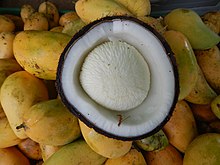
Back হাস্টোরিয়াম Bengali/Bangla Haustori Catalan Haustorium German Haŭstorio Esperanto Haustor Estonian اندام مکنده Persian Haustorium French Diúlán Irish Haustorio Galician Haustorij Croatian
This article needs additional citations for verification. (May 2007) |



In botany and mycology, a haustorium (plural haustoria) is a rootlike structure that grows into or around another structure to absorb water or nutrients. For example, in mistletoe or members of the broomrape family, the structure penetrates the host's tissue and draws nutrients from it. In mycology, it refers to the appendage or portion of a parasitic fungus (the hyphal tip), which performs a similar function. Microscopic haustoria penetrate the host plant's cell wall and siphon nutrients from the space between the cell wall and plasma membrane but do not penetrate the membrane itself.[1] Larger (usually botanical, not fungal) haustoria do this at the tissue level.
The etymology of the name corresponds to the Latin word haustor meaning the one who draws, drains or drinks,[2][3] and refers to the action performed by the outgrowth.
- ^ Szabo, Les (July 3, 2001). "Hidden robbers: The role of fungal haustoria in parasitism of plants". PNAS. 98 (14): 7654–7655. Bibcode:2001PNAS...98.7654S. doi:10.1073/pnas.151262398. PMC 35395. PMID 11438718.
- ^ Gaffiot, Félix (1934). Dictionnaire illustré Latin-Français (in French). Paris: Librairie Hachette. p. 737. Retrieved 13 May 2020.
- ^ haustor. Charlton T. Lewis and Charles Short. A Latin Dictionary on Perseus Project.